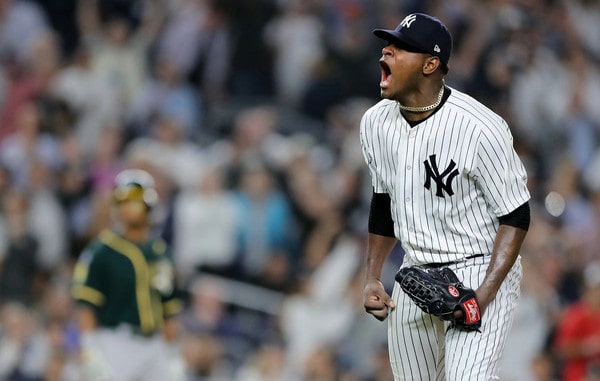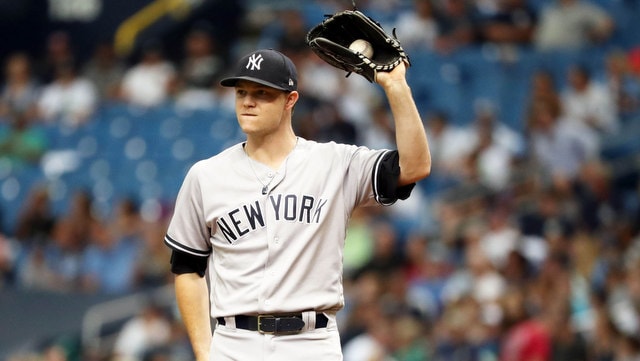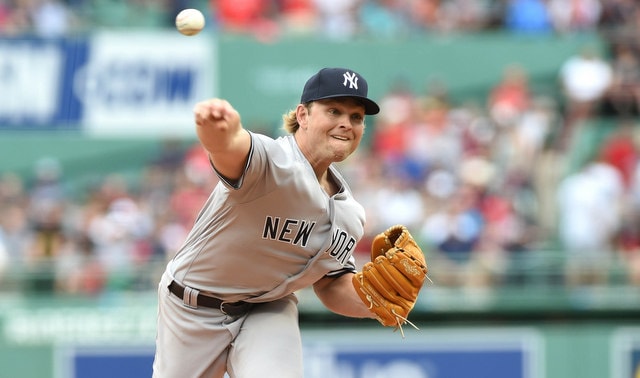
The Yankees are reportedly hoping to add another starting pitcher before the season begins, which both is and isn’t surprising. It is surprising, because they currently have six starters under contract for 2019, plus Jordan Montgomery slated to return from Tommy John surgery around the All-Star break. At the same time, it is not surprising because Masahiro Tanaka, James Paxton, and CC Sabathia (who also just had heart surgery) make semi-frequent trips to the disabled list, and Sonny Gray is persona non grata. Oh, what a tangled web we weave.
Given that, it stands to reason that the Yankees may not want to invest heavily in an ‘in case of emergency’ starter; and, by the same thought process, there’s no guarantee that any pitcher on the market would accept such a role (or the pay scale that’s likely to come with it). And all of that is my roundabout way of saying that the job is most likely to go to a pitcher looking to rebuild his value and/or simply not in high demand.
So let’s talk about Drew Pomeranz.
Background
The 30-year-old Pomeranz was the fifth overall pick by the Cleveland Indians back in 2010, and, as one would expect from his draft position, was immediately considered a top prospect. He was ranked as the 61st best prospect in the game heading into 2011 by Baseball America, and climbed up to number 30 prior to the 2012 season. And he made his MLB debut in September of 2011, albeit as a member of the Colorado Rockies (he was the prize of the Ubaldo Jimenez trade).
Pomeranz was mostly an up-and-down arm for the next two years, struggling to find success or a straightforward role with the Rockies. He was dealt to the Oakland A’s for Brett Anderson in the 2013-14 off-season, and it was in Oakland that he would settle-in as a swingman – and thrive. He’s been a big-leaguer ever since, pitching for the Padres and, most recently, the Red Sox.
Recent Performance
A year ago, this section would have looked absolutely stellar. Unfortunately – or fortunately, for suitors that believe in his ability to bounce back – 2018 did happen. In the interest of capturing where my positivity that will follow comes from, take a look at Pomeranz’s production from his 2015 breakout forward:
| G (GS) | IP | K% | BB% | GB% | HR/9 | ERA | FIP | |
|---|---|---|---|---|---|---|---|---|
| 2014 | 20 (10) | 69.0 | 23.0% | 9.4% | 45.7% | 0.91 | 2.35 | 3.77 |
| 2015 | 53 (9) | 86.0 | 23.0% | 8.7% | 42.2% | 0.84 | 3.66 | 3.62 |
| 2016 | 31 (30) | 170.2 | 26.5% | 9.3% | 46.2% | 1.16 | 3.32 | 3.80 |
| 2017 | 32 (32) | 173.2 | 23.5% | 9.3% | 43.2% | 0.98 | 3.32 | 3.84 |
| 2018 | 26 (11) | 74.0 | 19.2% | 12.8% | 37.1% | 1.46 | 6.08 | 5.43 |
That’s four very good to great years in a row, followed-up by a big time stinker in 2018. So what the heck happened? In short: everything.
Pomeranz got a late start to the 2018 due to a forearm strain, and he never really got on-track after returning in late-April. His strikeout and groundball rates were way down, and his walk and home run rates were way up, and that’s … well … really bad. And he was hit way harder than he ever had been before:

You see those blue-ish marks? All of those mean that he was in the bottom-5% of the league in 2018. Again, that’s really bad. It’s so bad, in fact, that it’s difficult to mine the data for anything even bordering on positive, or suggestive of the year being overtly flukish. And this is why Pomeranz hasn’t been popping up in many rumors, if any, and why I’d hazard that he’ll end up signing on the cheap.
That being said, you cannot simply ignore the four previous seasons. He had success in the bullpen and in the rotation, and he thrived in the AL East for a year and a half. Above-average strikeout rates along with average groundball and walk rates is a recipe for at least a reasonable amount of success.
The Stuff
The vast majority of Pomeranz’s offerings are his four-seam fastball and curveball, which generally account for between 75 and 80% of his selection. However, he also throws a sinker, a cutter, and a change-up. Here’s how they look velocity-wise:

And the rightmost dots on the graph give us what may well be the reason for Pomeranz’s struggles last year: his velocity dropped by over a MPH on everything but his infrequently used change-up. His elite spin rates (especially on his curveball, which is among the best in the game) remained intact, per Statcast, but nothing had the same oomph. And, as you can tell from his walk rate above, he couldn’t locate, either.
Pomeranz blamed the lack of velocity and struggles with location on rust and mechanical issues, which seems fair. I’m putting off the injury talk for a bit longer, but he did miss a significant amount of time last season with a couple DL stints, and he also may’ve been tipping pitches. That doesn’t exactly make him an appealing option – but it must just be fixable.
And this is what his curveball looks like, up close and personal:
Drew Pomeranz, Curveball (grip/release/spin/scratchreel). #SRGif pic.twitter.com/p0IPyBC5Kn
— Rob Friedman (@PitchingNinja) May 26, 2017
How can you not want a shot at fixing that?
Injury History
Here’s the elephant in the room: Pomeranz opened the season on the DL with a forearm/flexor strain. That doesn’t sound good. And then he spent almost all of June and July on the DL once again with biceps tendinitis. Both injuries impacted his left arm, too. And that’s not encouraging.
This isn’t the first time that he has dealt with an injury to his pitching arm, either. When the Red Sox acquired him from the Padres in 2016, there was a mild uproar when it turned out that the Padres didn’t disclose information about Pomeranz receiving some manner of treatment for his arm. In fact, Padres GM A.J. Preller was suspended for this offense. Pomeranz would end up having stem cell treatment for what was described as a flexor tendon issue that off-season.
And that came just a year after he had “minor” shoulder surgery for a clavicle resection. Add in a broken wrist in 2014 and biceps tendinitis in 2013, and it seems as if Pomeranz has never been truly healthy for a full season. He managed to make 30-plus starts in 2016 and 2017, though, and you can’t take that away from him.
Contract Estimate
Given the way this off-season has unfolded, just imagine me shrugging here. There are a variety of one-year pillow contract estimates floating around the internet, and that’s probably what Pomeranz will end up with. I’d assume it’ll be a low base salary with tons of incentives, for what it’s worth.
Does He Make Sense for the Yankees?
In my mind, the Yankees desire for another starter is more akin to adding legitimate rotation depth than adding an actual starter. And, even with his injury issues and rocky 2018, I think that Pomeranz is all but a perfect fit for what the team could use. My rapid-fire reasoning:
- He’s had success in the AL East
- He’s a lefty
- His curveball is among the best in the game
- He has plenty of experience as a swingman
- He’ll come cheap
I wouldn’t expect Pomeranz to repeat his 2016 and 2017, but I think that 2018 can largely be chalked-up as a lost season. It doesn’t sound as though he was ever really healthy, and there are plenty of rumblings that the Red Sox rushed him back not once, but twice last year. Give him an off-season of rest, ease him into the team as a long-reliever, and have him be first in-line for a spot start. And I genuinely believe he can be an asset in such a role – he’ll be 30 for the entirety of the season, after all, so it feels too early to write him off.








